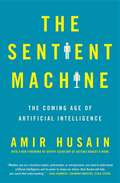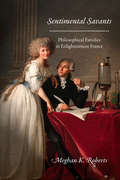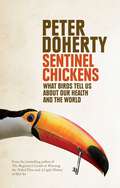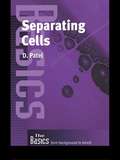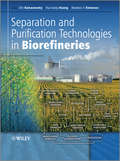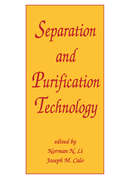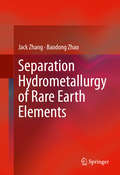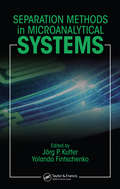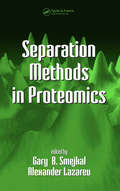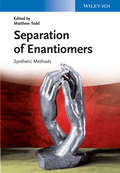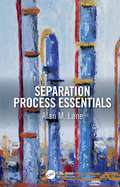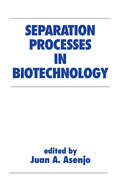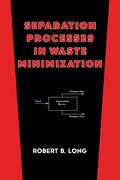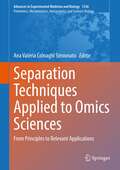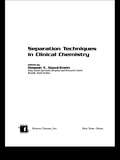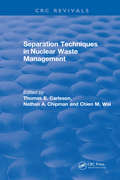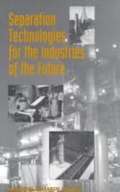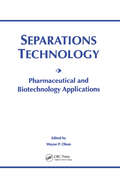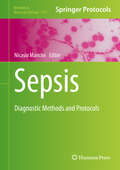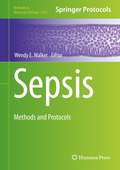- Table View
- List View
The Sentient Machine: The Coming Age of Artificial Intelligence
by Amir Husain&“A must-read for anyone looking to understand how artificial intelligence is poised to transform human society and life.&” —Paul Scharre, Author of Four Battlegrounds: Power in the Age of Artificial Intelligence The future is now. Acclaimed technologist and inventor Amir Husain explains how we can live amidst the coming age of sentient machines and artificial intelligence—and not only survive, but thrive.Artificial &“machine&” intelligence is playing an ever-greater role in our society. We are already using cruise control in our cars, automatic checkout at the drugstore, and are unable to live without our smartphones. The discussion around AI is polarized; people think either machines will solve all problems for everyone, or they will lead us down a dark, dystopian path into total human irrelevance. Regardless of what you believe, the idea that we might bring forth intelligent creation can be intrinsically frightening. But what if our greatest role as humans so far is that of creators? Amir Husain, a brilliant inventor and computer scientist, argues that we are on the cusp of writing our next, and greatest, creation myth. It is the dawn of a new form of intellectual diversity, one that we need to embrace in order to advance the state of the art in many critical fields, including security, resource management, finance, and energy. &“In The Sentient Machine, Husain prepares us for a brighter future; not with hyperbole about right and wrong, but with serious arguments about risk and potential&” (Dr. Greg Hyslop, Chief Technology Officer, The Boeing Company). He addresses broad existential questions surrounding the coming of AI: Why are we valuable? What can we create in this world? How are we intelligent? What constitutes progress for us? And how might we fail to progress? Husain boils down complex computer science and AI concepts into clear, plainspoken language and draws from a wide variety of cultural and historical references to illustrate his points. Ultimately, Husain challenges many of our societal norms and upends assumptions we hold about &“the good life.&”
Sentimental Savants: Philosophical Families in Enlightenment France
by Meghan K. RobertsThough the public may retain a hoary image of the lone scientific or philosophical genius generating insights in isolation, scholars discarded it long ago. In reality, the families of scientists and philosophers in the Enlightenment played a substantial role, not only making space for inquiry within the home but also assisting in observing, translating, calculating, and illustrating. Sentimental Savants is the first book to explore the place of the family among the savants of the French Enlightenment, a group that openly embraced their families and domestic lives, even going so far as to test out their ideas--from education to inoculation--on their own children. Meghan K. Roberts delves into the lives and work of such major figures as Denis Diderot, Émilie Du Châtelet, the Marquis de Condorcet, Antoine Lavoisier, and Jérôme Lalande to paint a striking portrait of how sentiment and reason interacted in the eighteenth century to produce not only new kinds of knowledge but new kinds of families as well.
Sentinel Chickens: What Birds Tell Us About Our Health And Our World
by Peter Doherty'The idea of 'sentinel chickens' seemed pretty incongruous when I first heard the phrase as a young undergraduate ... The notion of the humble chicken waiting like a trained soldier, alert and focused, for some unseen and approaching enemy just didn't seem likely. Hens en garde!' And yet guard they do. Not only chickens, but puffins, eagles, canaries and toucans- birds of all kinds are recruited by humans to help us interpret changes in our increasingly challenged and unpredictable world. These wonderful creatures continually sample the atmosphere, oceans, fields and forests, signalling toxic and environmental dangers that threaten all vertebrates. Through personal stories and fascinating examples, Nobel prizewinner Peter Doherty shows also how birds have contributed to cutting-edge medical research. Studying birds has helped us to understand the nature of human cancer, malaria and influenza, and contributed to the development of new vaccines and cures. In his trademark style, Peter argues that since birds pollenate, spread plant seeds and control insects, endangering their habitats through human activities is a threat to our own wellbeing. Sentinel Chickens shows why we should give our feathered friends our close, sustained and caring attention.
Separate Beds: A History of Indian Hospitals in Canada, 1920s-1980s
by Maureen K. LuxSeparate Beds is the shocking story of Canada's system of segregated health care. Operated by the same bureaucracy that was expanding health care opportunities for most Canadians, the "Indian Hospitals" were underfunded, understaffed, overcrowded, and rife with coercion and medical experimentation. Established to keep the Aboriginal tuberculosis population isolated, they became a means of ensuring that other Canadians need not share access to modern hospitals with Aboriginal patients.Tracing the history of the system from its fragmentary origins to its gradual collapse, Maureen K. Lux describes the arbitrary and contradictory policies that governed the "Indian Hospitals," the experiences of patients and staff, and the vital grassroots activism that pressed the federal government to acknowledge its treaty obligations.A disturbing look at the dark side of the liberal welfare state, Separate Beds reveals a history of racism and negligence in health care for Canada's First Nations that should never be forgotten.
A Separate Space: Creating a Military Service for Space
by Michael Spirtas Yool Kim Frank Camm Shirley M. Ross Debra Knopman Forrest E. Morgan Sebastian Joon Bae M. Scott Bond John S. Crown Elaine SimmonsAs the United States creates the Space Force as a service within the Department of the Air Force, RAND assessed which units to bring into the Space Force, analyzed career field sustainability, and drew lessons from other defense organizations. The report focuses on implications for effectiveness, efficiency, independence, and sense of identity for the new service.
Separating Cells (The\basics Ser.)
by Dipak PatelSeparating Cells: The basics provides user-friendly and practical guidance to the techniques most commonly used to separate cells. The book offers a concise overview of the fundamental principles and explains the 'what, how and why'. This title will be of considerable interest to newcomers to these techniques.
Separation and Purification Technologies in Biorefineries
by Shri Ramaswamy Huajiang Huang Bandrau RamaraoSeparation and purification processes play a critical role in biorefineries and their optimal selection, design and operation to maximise product yields and improve overall process efficiency. Separations and purifications are necessary for upstream processes as well as in maximising and improving product recovery in downstream processes. These processes account for a significant fraction of the total capital and operating costs and also are highly energy intensive. Consequently, a better understanding of separation and purification processes, current and possible alternative and novel advanced methods is essential for achieving the overall techno-economic feasibility and commercial success of sustainable biorefineries. This book presents a comprehensive overview focused specifically on the present state, future challenges and opportunities for separation and purification methods and technologies in biorefineries. Topics covered include: Equilibrium Separations: Distillation, liquid-liquid extraction and supercritical fluid extraction. Affinity-Based Separations: Adsorption, ion exchange, and simulated moving bed technologies. Membrane Based Separations: Microfiltration, ultrafiltration and diafiltration, nanofiltration, membrane pervaporation, and membrane distillation. Solid-liquid Separations: Conventional filtration and solid-liquid extraction. Hybrid/Integrated Reaction-Separation Systems: Membrane bioreactors, extractive fermentation, reactive distillation and reactive absorption. For each of these processes, the fundamental principles and design aspects are presented, followed by a detailed discussion and specific examples of applications in biorefineries. Each chapter also considers the market needs, industrial challenges, future opportunities, and economic importance of the separation and purification methods. The book concludes with a series of detailed case studies including cellulosic bioethanol production, extraction of algae oil from microalgae, and production of biopolymers. Separation and Purification Technologies in Biorefineries is an essential resource for scientists and engineers, as well as researchers and academics working in the broader conventional and emerging bio-based products industry, including biomaterials, biochemicals, biofuels and bioenergy.
Separation and Purification Technology
by Norman LiThis book provides a sampler of developments in separation and purification technology, focusing on the application of membrane-based separations in biotechnology, commercial applications of emulsion liquid membranes, and economic evaluation of membrane technology.
Separation Hydrometallurgy of Rare Earth Elements
by Jack Zhang Baodong Zhao Bryan SchreinerThis book describes in a comprehensive manner the technical aspects of separation of rare earth elements into individual elements for industrial and commercial use. The authors include details on and differentiate among the effective separation of rare earth elements for various parts of the world. They introduce new applications of separation of rare earth elements from concentrates of diverse ore types.
Separation Methods In Microanalytical Systems
by Jörg P. Kutter Yolanda FintschenkoFocusing on what has been one of the driving forces behind the development of lab-on-a-chip devices, Separation Methods in Microanalytical Systems explores the implementation, realization, and operation of separation techniques and related complex workflows on microfabricated devices. The book details the design, manufacture, and integration of diverse components needed to perform an entire analytical procedure on a single miniaturized device. This volume is valuable reference for scientists and engineers anticipating the demand for function-specific chemical separation systems in biomedical diagnostics, environmental monitoring, and drug discovery applications.
Separation Methods In Proteomics
by Gary B. Smejkal Alexander LazarevDriven by the widespread growth of proteomic practices, protein separation techniques have been refined to minimize variability, optimize particular applications, and adapt to user preferences in the analysis of proteins.Separation Methods in Proteomics provides a comprehensive examination of all major separation techniques for proteomic
Separation of Enantiomers
by Matthew H. ToddIn one handy volume this handbook summarizes the most common synthetic methods for the separation of racemic mixtures, allowing an easy comparison of the different strategies described in the literature.Alongside classical methods, the authors also consider kinetic resolutions, dynamic kinetic resolutions, divergent reactions of a racemic mixture, and a number of "neglected" cases not covered elsewhere, such as the use of circularly polarized light, polymerizations, "ripening" processes, dynamic combinatorial chemistry, and several thermodynamic processes. The result is a thorough introduction to the field plus a long-needed, up-to-date overview of the chemical, biological, and physical methods and their applications. Newcomers to the field, students as well as experienced synthetic chemists will benefit from the highly didactic presentation: Every method is presented in detail, from relatively simple separation problems to advanced complex resolution methods.
Separation of Molecules, Macromolecules and Particles
by Kamalesh K. SirkarProviding chemical engineering undergraduate and graduate students with a basic understanding of how separation of a mixture of molecules, macromolecules or particles is achieved, this textbook is a comprehensive introduction to the engineering science of separation. • Students learn how to apply their knowledge to determine the separation achieved in a given device or process. • Real-world examples are taken from biotechnology, chemical, food, petrochemical, pharmaceutical and pollution control industries. • Worked examples, elementary separator designs and chapter-end problems, giving students a practical understanding of separation. The textbook systematically develops different separation processes by considering the forces causing the separation, and how this separation is influenced by the patterns of bulk flow in the separation device. Readers will be able to take this knowledge and apply it to their own future studies and research in separation and purification. Online resources include solutions to the exercises and guidance for computer simulations.
Separation Process Essentials
by Alan M. LaneSeparation Process Essentials provides an interactive approach for students to learn the main separation processes (distillation, absorption, stripping, and solvent extraction) using material and energy balances with equilibrium relationships, while referring readers to other more complete works when needed. Membrane separations are included as an example of non-equilibrium processes. This book reviews and builds on material learned in the first chemical engineering courses such as Material and Energy Balances and Thermodynamics as applied to separations. It relies heavily on example problems, including completely worked and explained problems followed by "Try This At Home" guided examples. Most examples have accompanying downloadable Excel spreadsheet simulations. The book also offers a complementary website, http://separationsbook.com, with supplementary material such as links to YouTube tutorials, practice problems, and the Excel simulations. This book is aimed at second and third year undergraduate students in Chemical engineering, as well as professionals in the field of Chemical engineering, and can be used for a one semester course in separation processes and unit operations.
Separation Processes in Biotechnology (Biotechnology And Bioprocessing Ser. #9)
by Juan A. AsenjoEdited to avoid duplication and favor comprehensiveness, 20 contributors detail the recovery, separation, and purification operations of bioprocess technology. Individual chapters in this classic yet still highly relevant work emphasize concepts that are becoming more and more important when applied to the large scale versions of techniques that are considered well established. Aside from fully discussing processes, Separation Processes in Biotechnology includes sections on concentration separation and operation, purification operations, and product release and recovery. It also discusses plant operation and equipment and delves into economic considerations
Separation Processes in Waste Minimization
by Robert B. LongThis work offers an accessible discussion of current and emerging separation processes used for waste minimization, showing how the processes work on a day-to-day basis and providing troubleshooting tips for equipment that doesn't function according to design specifications. It describes the fundamentals of over 30 processes, types of equipment available, vendors, and common problems encountered in operations with hazardous waste.
Separation Techniques Applied to Omics Sciences: From Principles to Relevant Applications (Advances in Experimental Medicine and Biology #1336)
by Ana Valéria Colnaghi SimionatoThis book covers liquid chromatography, gas chromatography and capillary electrophoresis, the three main separation techniques lately available, applied to key omic sciences, such as genomics, proteomics, metabolomics and foodomics. The fundamentals of each technique are not covered herein. Instead, the recent advances in such techniques are presented focusing on the application to omics analyses and unique aspects in each case. This volume intends to offer wide ranging options available to researchers on omics sciences, and how to integrate them in order to achieve the comprehension of a biological system as a whole. Omic sciences have been of ultimate importance to comprehend the complex biochemical reactions and related events that occurs upon a biological system. The classical central dogma of molecular biology, which states that genetic information flows unidirectionally from DNA to RNA and then to proteins, has been gradually replaced by the systems biology approach. This book presents a multidisciplinary approach that explains the biological system as a whole, where the entire organism is influenced by a variety of internal events as well as by the environment, showing that each level of the biological information flux may influence the previous or the subsequent one.
Separation Techniques in Clinical Chemistry
by Hassan Y. Aboul-EneinThis reference examines innovations in separation science for improved sensitivity and cost-efficiency, increased speed, higher sample throughput and lower solvent consumption in the assessment, evaluation, and validation of emerging drug compounds. It investigates breakthroughs in sample pretreatment, HPLC, mass spectrometry, capillary electrophor
Separation Techniques in Nuclear Waste Management: Separation Techniques In Nuclear Waste Management (1995) (CRC Press Revivals)
by Thomas E Carleson Chien M. Wai Nathan A. ChipmanSeparation Techniques in Nuclear Waste Management is an up-to-date, comprehensive survey of processes for separation of nuclear wastes. Comprised of articles by scientists and engineers at universities and national laboratories in the U.S. and overseas, the book provides excellent reference information for individuals working in nuclear waste management.Specifically, the book covers current separation technologies and techniques for waste liquid, solid, and gas streams that contain radionuclides. Such wastes are typical of those produced as a result of nuclear materials processing and spent fuel reprocessing. Chapters on promising new technologies and state-of-the-art processes currently in use provide valuable information for design engineers, as well as for research scientists. The articles in Separation Techniques in Nuclear Waste Management are brief and concise - designed for quick access to pertinent information. Many of the contributors are leaders in their fields. It is the most current survey available of the latest nuclear waste management techniques.
Separation Technologies for the Industries of the Future
by Panel on Separation Technology for Industrial Reuse RecyclingSeparation processes—or processes that use physical, chemical, or electrical forces to isolate or concentrate selected constituents of a mixture—are essential to the chemical, petroleum refining, and materials processing industries.In this volume, an expert panel reviews the separation process needs of seven industries and identifies technologies that hold promise for meeting these needs, as well as key technologies that could enable separations. In addition, the book recommends criteria for the selection of separations research projects for the Department of Energy's Office of Industrial Technology.
Separations Technology: Pharmaceutical and Biotechnology Applications
by Wayne P. OlsonAuthored by a team of respected scientists and technologists, this book covers many pharmaceutical and biotechnology separations methods currently in use. Practical applications and descriptions are offered for air elutriation, microporous filtration, ultrafiltration, phase partitioning, crystallization, and chromatographic technologies such as adsorption, affinity, chelate, ion-exchange, size-exclusion, template, hydrophobic interaction, biotransformations, and chiral separations.Containing hundreds of references and a complete index, this book is designed for research and development scientists, process optimization engineers, and quality control laboratory scientists as well as quality assurance professionals and others needing to understand current separation techniques.
Sepsis
by Nicasio ManciniThis volume covers microbiological, clinical and patophysiological aspects of sepsis and also provides general overview chapters with every chapter discussing the real clinical impact of the discussed diagnostic approaches. Sepsis is a major clinical problem that takes an inordinate toll on human lives and economical resources. It is widely recognized that inappropriate treatment is associated with a dramatic increase in mortality, especially within the first hours, therefore clinical and microbiological diagnosis are of pivotal importance in the management of septic patients. Written in the successful Methods in Molecular Biology series format, chapters include introductions to their respective topics, lists of the necessary materials and reagents, step-by-step, readily reproducible protocols, and notes on troubleshooting and avoiding known pitfalls. Authoritative and easily accessible, Sepsis: Diagnostic Methods and Protocols seeks to serve both professionals and novices with its well-honed methodologies in an effort to further our knowledge of this life-threatening illness.
Sepsis: Methods and Protocols (Methods in Molecular Biology #2321)
by Wendy E. WalkerThis detailed volume presents a variety of animal models that are commonly used to study sepsis and some key procedures to measure specific disease outcomes. The chapters describe well-established surgical and nonsurgical rodent models of sepsis, presented by experts in the field. In addition, the book includes protocols for burn injury and sepsis, modeling the mouse intensive care unit (MICU), and the development of humanized mice, which may be useful tools to increase the translational potential of rodent sepsis research. There is a chapter discussing the use of biomarkers for sepsis diagnosis and prognosis in humans and mice, as well as chapters describing specific methods for biomarker measurement, and the use of analgesics and humane endpoints in rodent sepsis research. Finally, agent-based computational modeling is presented as a valuable complementary approach to study sepsis. Written for the highly successful Methods in Molecular Biology series, chapters include introductions to their respective topics, lists of the necessary materials and reagents, step-by-step, readily reproducible laboratory protocols, and tips on troubleshooting and avoiding known pitfalls. Authoritative and practical, Sepsis: Methods and Protocols serves as an ideal guide for researchers working toward improving the identification and treatment of septic patients.
Sepup Science and Global Issues: Biology
by University of California at Berkeley Lawrence Hall of ScienceSepup's Science And Global Issues: Biology is a different kind of science course in three important ways. First, it is student-centered, with the goal of helping all students to understand and enjoy science. Second, it is authentic to the way scientists work, and it asks you to begin to think and investigate as a scientist does. Finally, it is organized around important global issues related to sustainability.
SEPUP Science and global Issues Biology
by Lab-AidsSepup's science and global issues: biology is a different kind of science course in three important ways. First, it is student-centered, with the goal of helping all students to understand and enjoy science. Second, it is authentic to the way scientists work, and it asks you to begin to think and investigate as a scientist does. Finally, it is organized around important global issues related to sustainability. Students and their teachers around the United States tested this course and gave feedback, which we used to revise and improve the program. From this testing we learned what high school students find interesting, what is easier or more difficult for you to learn, and how to provide learning experiences to help you progress in your understanding of science. During this course you will participate in a wide range of activities, including hands-on labs, hands-on models, interactive computer simulations of scientific concepts, readings describing how scientific theories are developed and are applied today, and discussions and debates. You will also connect what you learn to your own life, your community, and the world.
